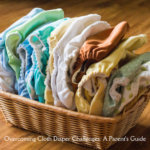In an era where environmental consciousness is more than a trend, reusable diapers are gaining momentum as a practical, eco-friendly choice for modern families. As a father of three vibrant children, my journey into the world of reusable diapering was born out of a desire to contribute positively to our planet and to provide a healthier, more natural upbringing for my offspring.
The Advantages of Reusable Diapers
Embarking on the reusable diaper path unveils a plethora of benefits, not only for our precious earth but also for our most precious ones. The environmental implications are profound; by opting for cloth over disposable, we significantly reduce landfill waste, conserving resources and protecting natural habitats. Economically, the initial investment in reusable diapers pays off, with savings accruing over time as the need to continually purchase disposables diminishes. Health-wise, reusable diapers, free from chemicals and perfumes found in their disposable counterparts, are gentler on babies’ delicate skin, reducing the risk of diaper rash and allergies, especially pertinent for my middle child, whose skin sensitivity initially propelled us towards cloth diapering.

Understanding the Types of Reusable Diapers
Diving into the world of cloth diapers can be overwhelming with the variety available. Prefolds and flats are the traditional choice, offering simplicity and versatility. Fitted diapers, with their snug fit, provide excellent leak protection. Pocket diapers, a favorite in our household, feature a customizable absorbency option, crucial for nighttime use. All-in-Ones (AIOs) offer unparalleled convenience, mimicking disposable diapers’ ease of use. Hybrid diapers, with their reusable and disposable insert options, provide a flexible solution for families on the go.
Choosing the Right Diaper for Your Baby
Selecting the appropriate diaper involves several considerations. For newborns, a diaper offering a snug fit around the legs and waist is crucial to prevent leaks. For babies with sensitive skin, like my daughter, materials such as organic cotton or bamboo provide a soft, irritant-free experience. Absorbency is key for nighttime use, ensuring a peaceful sleep for both baby and parents.
Cost Comparison: Reusable vs Disposable Diapers
The cost-effectiveness of reusable diapers is undeniable. While the upfront cost may seem daunting, the long-term savings are substantial. Our family’s transition to cloth diapers was initially motivated by the economic advantage, providing us the financial flexibility to allocate resources to other areas of our children’s upbringing.

How to Clean and Maintain Reusable Diapers
Contrary to popular belief, maintaining reusable diapers is not as labor-intensive as it seems. Establishing a routine involving a cold rinse followed by a hot wash with a gentle, eco-friendly detergent has been effective for us. Sun-drying not only saves energy but also naturally bleaches stains, keeping the diapers fresh and sanitary.
Transitioning to Reusable Diapers: A Step-by-Step Guide
Transitioning to cloth diapers doesn’t have to be an all-or-nothing approach. We started gradually, using cloth diapers during the day and disposables at night, slowly increasing cloth diaper usage as we became more comfortable with the washing routine. Involving my older children in the process, by letting them choose patterns and help with folding, fostered a sense of responsibility and teamwork.

Where to Buy Reusable Diapers
Finding the right place to purchase reusable diapers can be as simple as a click away or a short drive. Online platforms offer a vast selection, often with reviews that can guide new parents. Local baby stores also provide an opportunity to see and feel the diapers firsthand, with the added benefit of supporting local businesses.
DIY Tips for Reusable Diapering
For the crafty and cost-conscious, DIY diapering solutions abound. Making homemade diapers from old t-shirts or towels is not only economical but also adds a personal touch to your baby’s wardrobe. DIY diaper liners, made from fleece or bamboo, offer an easy-to-clean solution for solid waste, simplifying the laundering process.

Conclusion
The transition to reusable diapers is a journey that transcends mere cost savings and environmental benefits. It’s a lifestyle choice that reflects a commitment to our children’s health and our planet’s future. As I reflect on our family’s journey, the benefits of reusable diapering, both tangible and intangible, affirm our decision to embrace this sustainable practice. For families contemplating this switch, know that the path is rewarding, with each cloth diaper change contributing to a healthier child and a cleaner world.







